Return to main Vanishing B.C. page Return to home page
Page last updated December 3, 2023
© Michael Kluckner
|
The dramatic view of Sandon today is the one you get as you enter the town by the only road. Carpenter Creek, strewn with boulders and broken timbers, runs down the middle of a narrow valley with, inexplicably, the old City Hall building standing almost alone beside it. Surrounded on all sides by forested mountains and isolated in a deep, blue gloom during the winter months, it is a forlorn, fascinating place, with the snow settling in earlier and staying later than in other nearby towns like New Denver and Kaslo. The narrow valley evident heading into the right distance indicates the presence of Sandon Creek, which joins Carpenter Creek in the middle of the old townsite. Mount Cody looms in the background. (painted in 2002) |

Sandon City Hall on Carpenter Creek in early December.
Built in 1900, it was converted after the city's bankrupty into a
school and so used from 1925-1954.
It is one of the privately restored and maintained city buildings,
open in the summer.

|
2002: Two of the remaining historic buildings on the narrow road (Reco Street) leading to Cody, just past the Kaslo & Sandon Railway crossing. The second building along, with the "Cafe" sign, is the Tattrie House, built in 1895. It operates as Tin Cup Annie's in the summer. The nearer one is known as Dr. Gomm's house. Note from Barbara Fuhrer, March 27, 2008: I regret to tell you that the Tin Cup Cafe and the building next door burned to the ground in a fire a week ago. I live in Silverton, my boyfriend was working at the Mine in Sandon when it happened and all the miners responded to the blaze along with the New Denver Fire Dept, although it is techniquely out of their jurisdiction. It started in the basement of the Tin Cup, the woman inside was just able to escape with the clothes on her back, she and her husband lost everything they owned...Yes, it is a terrible shame. They were, however able to prevent the neighboring structures from catching by pumping water from the creek. |
"Tin Cup Annie's" and "Dr. Gomm's house" as they appeared in the
1960s.
Photo by an anonymous provincial government employee.
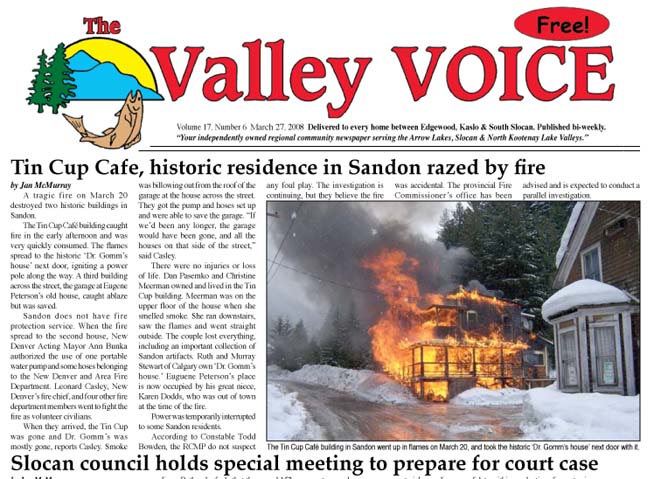
Valley Voice pdf submitted by Barbara Fuhrer
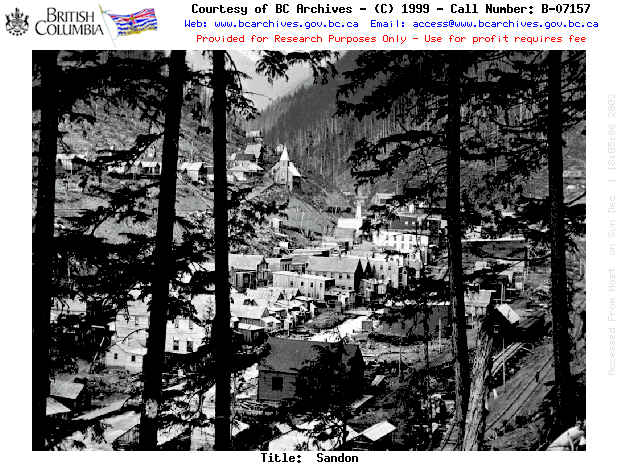
Sandon, 1898, at the peak of its prosperity in the silver boom
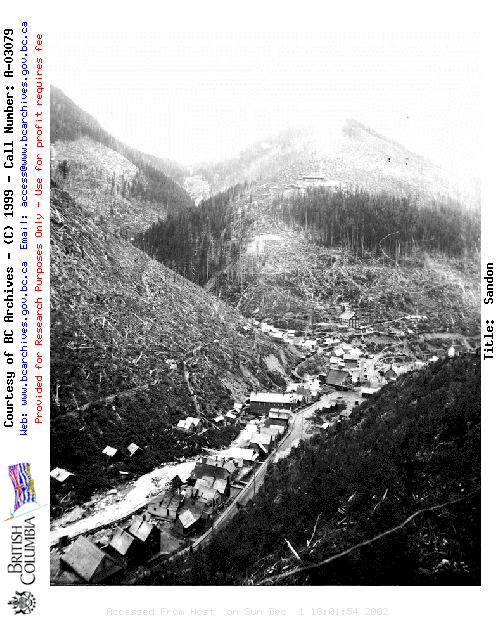
Sandon, 1902, being rebuilt after the catastrophic fire. Photographer unknown. Planked-over Carpenter Creek is clearly visible behind the line of houses
The Japanese-Canadian Internment
Please read the Wong's
Market page if you're unfamiliar with this part of British
Columbia history.
See also New Denver, Kaslo,
Slocan, Mayne
Island, Shuswap and Spuzzum
pages for further evidence of this saga.
I have a graphic novel – "Toshiko"
– about this period in BC history.
Sandon in 1941, the condition of the town at the beginning of the internment, photographer unknown. The decking over Carpenter Creek is evident.
Of all the god-forsaken places to be interned, there was Sandon –
colder and more isolated than the other ghost towns of the Kootenays and
Boundary country.
Somehow, 933 Japanese-Canadians were shoehorned into Sandon's
dilapidated buildings for the duration of the war.
I believe this was the Buddhist internment centre: Japanese-Canadians of
the various Christian denominations were located in the other camps.
|
|
First winter of internment – 1942-3 – at Sandon. Photos by Nobuo Domai. |
|
Note from Diana Domai: "This is a photo taken at the funeral of my husband's grandfather, in Sandon on January 23, 1943, temperature -29 degrees F. He was only 61 years of age when he died. My husband's mother always said she felt he died of a broken heart. Everything was taken from him, when the internment took place. Prior to the internment to Sandon he was a very successful fisherman from Steveston, B.C. "Kyujiro Domai was born on 14 May 1881 in Wakayama Prefecture, Japan. He was a fisherman who emigrated to British Columbia in 1901. He became a naturalized Canadian citizen in 1904, three years after arriving in Canada; he had to become naturalized in order to get a Fishing License [although he could not vote--ed.] He left his wife and two daughters behind in Mio village, Wakayama, Japan and came to Steveston to fish. He bought a salmon trawler and fished in the Gulf Islands. Kyujiro sent money home to his wife and two young daughters. When his daughter Hisae came to Canada at the age of eighteen years in 1933 to live, she felt she didn't know her father because he had been living and working in Canada so long. His fish trawler, which was his home as well as his livelihood, was confiscated at the outbreak of the war. He had slept, eaten and worked on his boat. It was a terrible shock for him to be taken away from the coast and interned in the ghost town of Sandon, B.C. He died in Sandon at the age of 61years, not that long after the Canadian Government sent him there along with his daughter Hisae and grandson Kyosuke (Kiyo). His son-in-law, Nobuo was sent to a road camp near Jasper, Alberta in 1942 but was in Sandon in 1943 when his father-in-law Kyujiro died of rheumatic fever." Sandon softball team 1943. Nobuo Domai is in the front row, far right. The Asahi team in Vancouver was one of the stars of the semi-pro league in the city before the First World War. There are a number of sites referring to their recent induction into the Canadian Baseball Hall of Fame. Both photos courtesy of Diana Domai. The Domais were subsequently moved to Lemon Creek.
* * * Sandon, 1968, with Carpenter Creek flowing in the foreground. The building on the left, the Hunter-Kendrick block built just after the 1900 fire, has been restored and houses the visitors centre and mining interpretation centre. The Virginia Hotel has disappeared. B.C. government photograph.
|

|
From Kay Thornton, 2023: I have been trying to find
some information on a building and the proprietor who once lived
in Sandon BC. His name was Cosam Bigney and he ran the
Sandon Bottling Co on Cody Ave. this would be circa
1901-2, previous to that it was run by Fitzgerald and Day, late
1800’s to when they sold the business to Bigney. 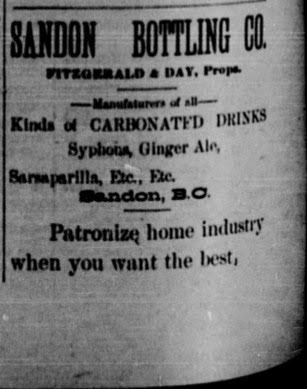 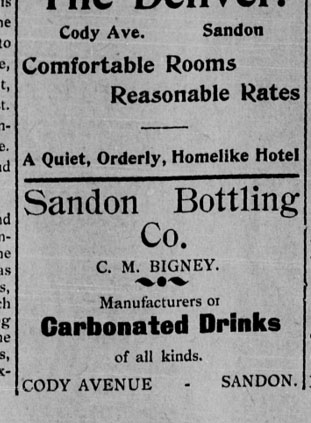
Note from Kjell Lennartsson, 2017: I'm from Sweden; I'm 67 years old theater actor, now retired and have time for searching my grandfather. I wonder if you have time for helping, I search my grand father. He works in Queen Bess Mine Camp near Sandon in British Columbia between 1916 -1919, which was what I know about him. After the latest letter from him 1920 he become silent or disappeared. I wonder if you have some contact that could help me and maybe will help me for that and have some knowledge about this historical time. Can I find some register of the mineworkers this time? Where? Or if you have an idea where I can find some date about him. So I can get something about him, or what happen him. I will come to this area, Slocan Valley, in this summer around 20june - 5july. Just for have looks were he live from 1912 to the last date of his letters. I will be very pleased if someone could or will help me. If you can, or if you know some other person who can know something about this time of mining and workers. And if there are someone who are interesting in it. Also if you know some person who are interesting for guiding me in the history of Sandon and the miners workers who lived there 1914 - 1920. I know few thing about my grandfather, for ex. He hurt or crush one of his knee so he was in a hospital in Ainsworth for a while, that was 1919 in an accident like 'mine collapse'.
The locomotive at Sandon, photographed by Bob Maruyama |
